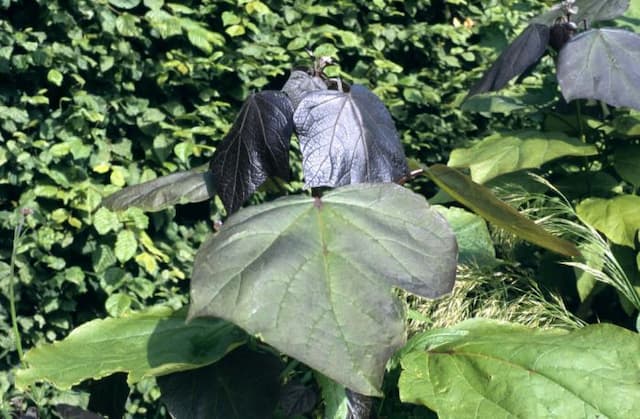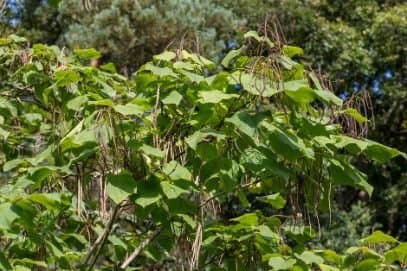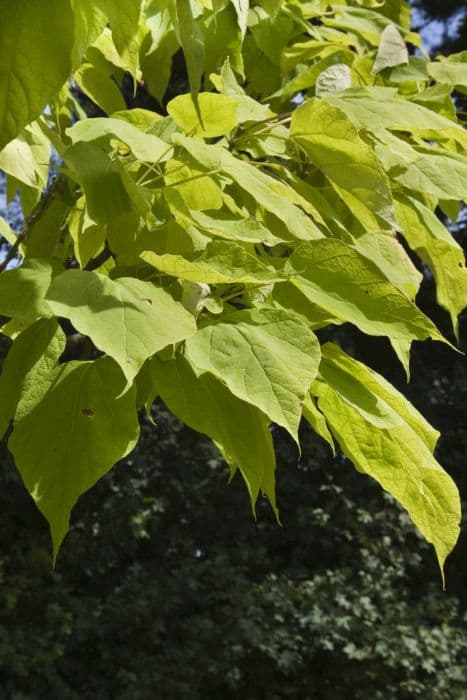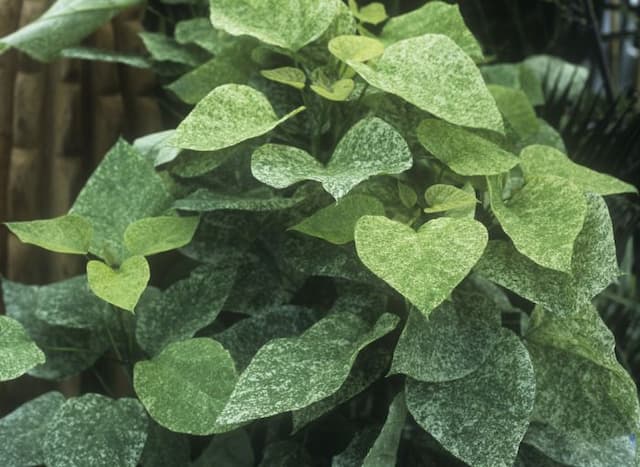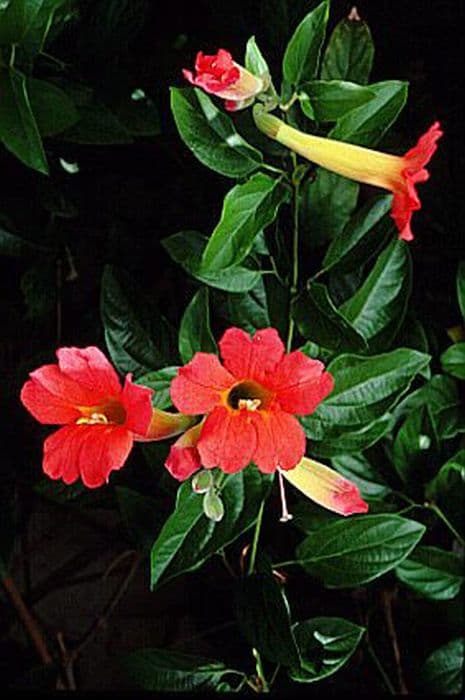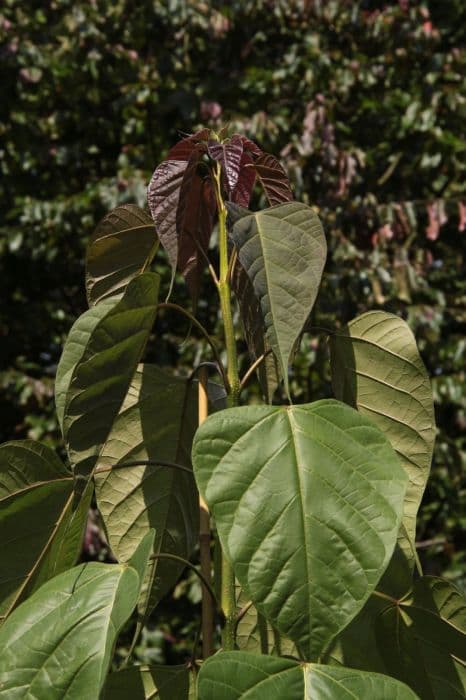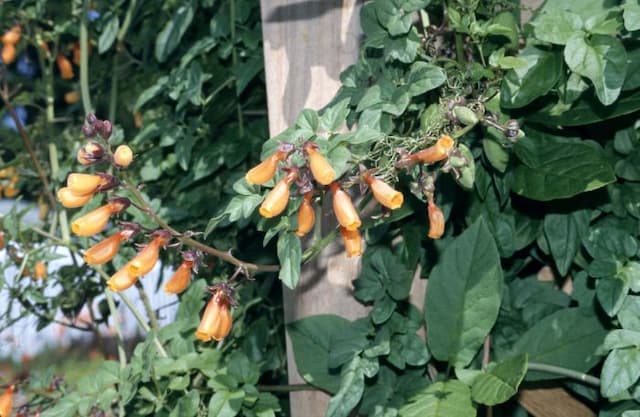Bower Vine Pandorea jasminoides 'Charisma' (v)

ABOUT
Pandorea jasminoides 'Charisma', commonly known as Bower of Beauty, is a visually striking plant noted for its variegated foliage and showy flowers. The leaves are divided into a number of leaflets, each boasting a light green center surrounded by a creamy white edge, giving the foliage a charismatic appearance. Such variegation adds a splash of brightness to any garden setting. The plant is a climber and it often drapes itself over structures or climbs up supports, displaying its foliage and blooms. During its flowering season, Bower of Beauty produces large, trumpet-shaped flowers. These blossoms are typically a soft pink or rose color, which can vary in intensity, and they often feature a deeper pink or red throat. The flowers are arranged in clusters, creating an enchanting display of color against the creamy-edged leaves. With its twining stems, Bower of Beauty can provide a lush, verdant look to trellises, fences, or arbors, making it a popular choice for adding vertical interest in gardens. Its vibrant flowers and striking variegated leaves together make it a delightful addition to any landscape that aims to combine color and texture for ornamental effect.
About this plant
 Names
NamesFamily
Bignoniaceae.
Synonyms
Bower Of Beauty, Bower Vine, Bower Climber, Pandorea.
Common names
Pandorea jasminoides 'Charisma' (v).
 Toxicity
ToxicityTo humans
The Bower Vine is generally considered non-toxic to humans. However, it is always advisable to avoid ingesting plants that are not known for being edible, as individuals may have varying sensitivities or allergic reactions. There are no well-documented symptoms of poisoning from the Bower Vine as it is not commonly regarded as a poisonous plant.
To pets
The Bower Vine is not commonly known to be toxic to pets. As with humans, it is always best to prevent pets from ingesting plants that are not specifically intended for them, due to the possibility of individual sensitivities or gastrointestinal upset. There are no specific symptoms of poisoning reported for pets ingesting this plant, but monitoring for any unusual behavior or signs of distress is recommended if ingestion occurs.
 Characteristics
CharacteristicsLife cycle
Perennials
Foliage type
Evergreen
Color of leaves
Variegated
Flower color
Pink
Height
20 feet (6 meters)
Spread
15 feet (4.5 meters)
Plant type
Climber
Hardiness zones
9
Native area
Australia
Benefits
 General Benefits
General Benefits- Ornamental Value: 'Charisma' adds aesthetic appeal to gardens with its striking variegated foliage and attractive trumpet-shaped flowers.
- Wildlife Attraction: The plant's flowers can attract hummingbirds and butterflies, enhancing biodiversity.
- Low Maintenance: Once established, it requires minimal care, making it suitable for gardeners of all levels.
- Fast-growing: It can rapidly cover trellises, fences, or walls, providing quick results for landscaping projects.
- Drought Tolerance: Once established, it can tolerate periods of drought, reducing the need for frequent watering.
- Versatility: The plant can be grown in containers or in the ground, making it suitable for various garden designs and spaces.
- Screening: It can be used to create a natural privacy screen or to hide unsightly areas of a garden.
 Medical Properties
Medical PropertiesThis plant is not used for medical purposes.
 Air-purifying Qualities
Air-purifying QualitiesThis plant is not specifically known for air purifying qualities.
 Other Uses
Other Uses- Potted Plant Decor: Bower vine can be used as an attractive ornamental plant in containers on patios or balcony gardens, adding a touch of greenery and color.
- Shade Provider: When planted in a garden, the dense foliage of the bower vine can create shaded areas which can be beneficial for providing cool spots during hot days.
- Privacy Screen: Bower vines can be grown against fences or trellises to create a living privacy screen, separating different parts of a garden or concealing spaces from view.
- Floral Arrangements: The attractive flowers of the bower vine can be cut and used in floral arrangements to provide a fragrant and aesthetic feature.
- Educational Tool: Horticulture educators can use the bower vine to teach students about climbing plant mechanisms and pollination strategies due to its twining growth habit and interaction with pollinators.
- Photography Subject: Bower vine, with its striking flowers and foliage, can serve as an excellent subject for botanical photography and art.
- Event Decoration: The plant can be incorporated into event decorations like weddings or garden parties, especially when grown in strategic locations to enhance the setting.
- Vertical Gardens: Bower vine is suitable for vertical gardening, helping to embellish bare, vertical spaces like balcony rails or wall planters.
- Cultural Significance: In some cultures, the bower vine may be used in traditional ceremonies or as a symbol within certain cultural practices due to its beauty.
- Wildlife Attraction: When planted in a garden, the flowers of the bower vine can attract beneficial insects such as bees and butterflies, which are important for pollination in the garden ecosystem.
Interesting Facts
 Feng Shui
Feng ShuiThe Bower Vine is not used in Feng Shui practice.
 Zodiac Sign Compitability
Zodiac Sign CompitabilityThe Bower Vine is not used in astrology practice.
 Plant Symbolism
Plant Symbolism- Beauty: The Pandorea jasminoides 'Charisma', commonly known as the Bower Vine, possesses delicate, attractive blooms that can symbolize beauty and charm, reflecting the aesthetic appeal that this plant brings to gardens and landscapes.
- Innocence: The Bower Vine's flowers, reminiscent of jasmine in appearance, have a pure and simple quality that can symbolize innocence.
- Peaceful Retreat: As a plant that can create shaded, secluded areas in gardens, the Bower Vine is often associated with the concept of sanctuary or peaceful retreat, a place of rest and relaxation away from the outside world.
 Water
WaterBower Vine requires regular watering, especially during its growing season in spring and summer. It's best to water deeply once a week, providing about 1.5 gallons for an established plant, ensuring you moisten the entire root zone. During hot, dry periods, you may need to water more frequently, but be sure to allow the soil to dry slightly between waterings to prevent root rot. In winter, reduce watering to once every two weeks or less, providing around 1 gallon, as the plant's water needs decrease in cooler temperatures.
 Light
LightBower Vine thrives in a spot that receives full sun to partial shade. Ideally, place the plant where it can get at least six hours of sunlight a day, but provide some protection during the hottest part of the day if you live in a region with very intense sun. An east or west-facing location is often perfect, as it provides bright light with some respite from the harsh afternoon sun.
 Temperature
TemperatureBower Vine performs best in temperatures ranging from 50°F to 85°F and can tolerate a brief dip down to about 30°F, although frost can damage the plant. Avoid exposing it to temperatures below this threshold. The ideal growing conditions include warm days and cooler nights, within the plant's preferred temperature range.
 Pruning
PruningPrune Bower Vine to maintain shape, encourage bushier growth, and remove any dead or damaged stems. The best time to prune is in late winter or early spring before new growth begins. Cut back the plant by one-third every couple of years to rejuvenate and stimulate new growth. Light pruning can be done throughout the growing season to keep the plant tidy.
 Cleaning
CleaningAs needed
 Soil
SoilBower vine thrives in a well-draining, fertile soil mix composed of equal parts loam, peat, and sharp sand or perlite. A slightly acidic to neutral pH, between 6.0 and 7.0, is ideal for this climbing plant to grow healthily. Regularly enriching the soil with organic matter helps maintain its structure and fertility.
 Repotting
RepottingBower vines should be repotted every 2 to 3 years to prevent becoming root-bound and to refresh the soil. Younger, fast-growing plants may require more frequent repotting, while mature plants can be repotted less often.
 Humidity & Misting
Humidity & MistingBower vines prefer moderate to high humidity levels, around 50% to 70%. Ensuring good air circulation around the plant will help prevent any potential issues with too high humidity, such as fungal infections.
 Suitable locations
Suitable locationsIndoor
Place in bright, indirect light and monitor watering.
Outdoor
Install in partial shade area; protect from strong winds.
Hardiness zone
9-11 USDA
 Life cycle
Life cyclePandorea jasminoides 'Charisma', commonly known as Bower of Beauty 'Charisma', begins its life cycle when a seed germinates, triggered by warmth and moisture. After germination, the seedling emerges and grows into a juvenile plant, developing a root system and foliage. As it matures, it develops vigorous twining stems and compound leaves with variegation, often used as an ornamental climber. During its flowering stage, typically in the warmth of late spring to summer, it produces trumpet-shaped flowers with pink and cream variegation, which attract pollinators. After pollination, it forms seed pods that eventually dry and release seeds to complete the cycle. Throughout its life, which can span many years in favorable conditions, the plant continues to grow and can be propagated through cuttings to create new plants.
 Propogation
PropogationPropogation time
Spring-Early Summer
The most popular method for propagating the Bower Vine, scientifically known as Pandorea jasminoides 'Charisma' (v), is semi-hardwood cuttings. This technique is usually performed in the late summer. To propagate, cut a piece of stem about 4 to 6 inches (10 to 15 centimeters) long, ensuring it has several sets of leaves. Strip the lower leaves and dip the cut end in rooting hormone powder to encourage root development. Then, insert the cutting into a mix of moistened potting soil and perlite or sand to enhance drainage. The cutting should be placed in a warm area with indirect light and kept moist. Roots typically develop within a few weeks, after which the cutting can be transplanted as its own plant.
